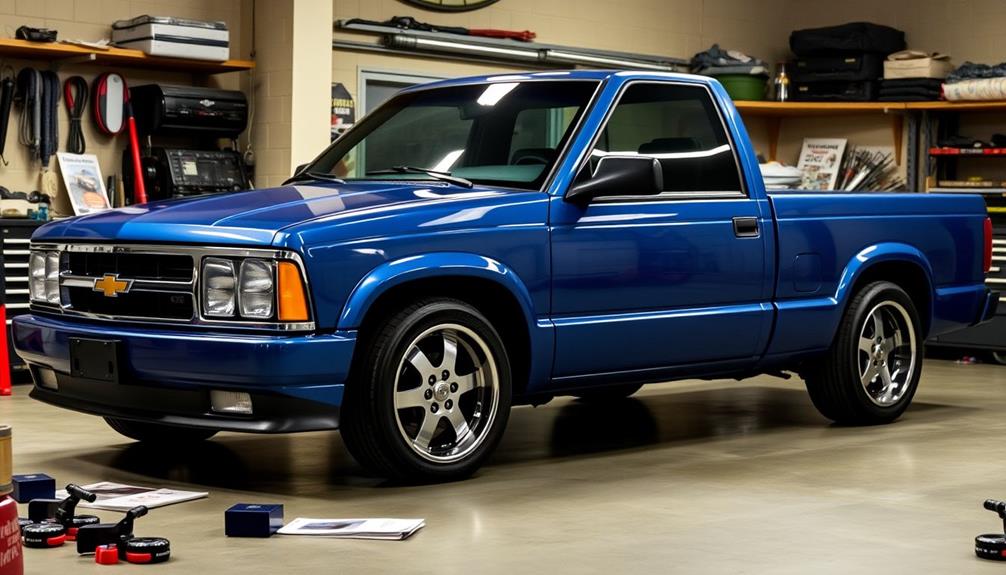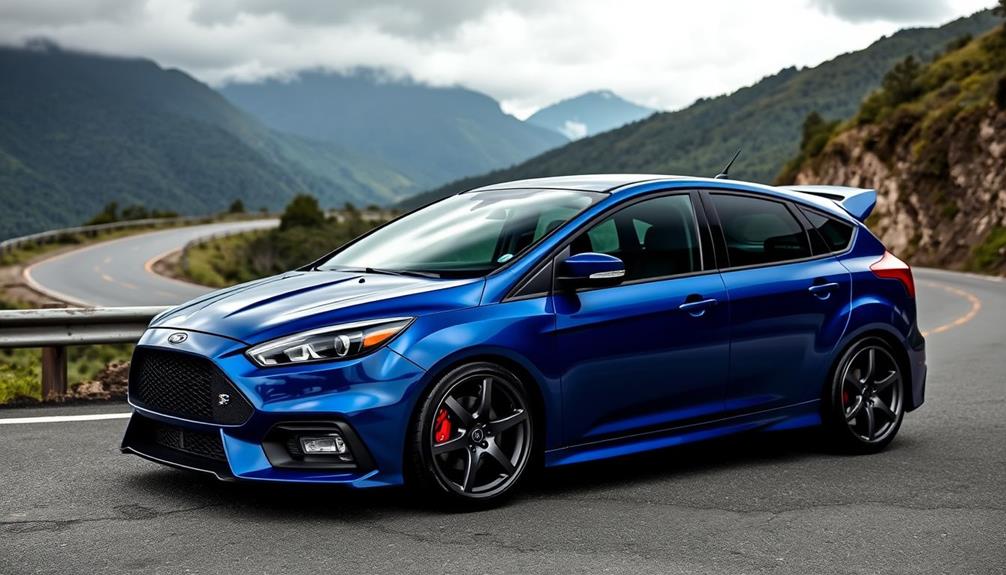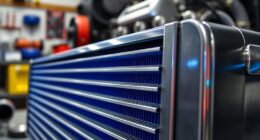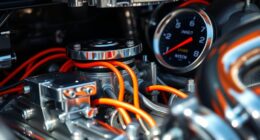To maximize your 2005 Ford Ranger's performance, start with key upgrades like a cold air intake, cat-back exhaust system, and custom tuning options like Xcal3. These enhancements can improve airflow, boost horsepower by up to 20%, and even increase fuel efficiency by 1-5 MPG. Consider adjusting global timing and optimizing shift points for better acceleration and drivability. While the aftermarket support for the 2.3L Duratec engine is limited, thoughtful tuning and performance parts can still make a noticeable difference. If you want to know more about specific upgrades and their benefits, there's plenty more to explore.
Key Takeaways
- Upgrade the airbox to improve airflow and gain up to 5 horsepower for better engine performance.
- Install a 2.5-inch cat-back exhaust system to enhance exhaust flow while meeting emissions standards.
- Utilize custom tuning options like Xcal3 to improve throttle response and potentially increase fuel mileage by 1-5 MPG.
- Consider aftermarket intercoolers to achieve performance increases of up to 9 kW at the wheels, enhancing overall engine efficiency.
- Focus on tuning strategies that optimize fuel tables and timing, potentially boosting horsepower and torque by 10-20%.
Performance Modifications Overview
When it comes to tuning your 2005 Ford Ranger, performance modifications are essential for optimizing your truck's capabilities. Upgrading your airbox can give you a noticeable boost, yielding up to 5 horsepower by enhancing airflow and responsiveness.
But that's just the start. Installing a cat-back 2.5-inch exhaust system with a high-flow muffler can greatly improve exhaust flow, contributing to overall horsepower gains while complying with emissions standards.
Custom tuning plays a critical role in maximizing these modifications. Options like the Xcal3 can enhance throttle response and drivability, with potential fuel mileage improvements of 1-5 MPG, depending on your specific setup.
You can also make global timing adjustments of +2 degrees and WOT fuel adjustments of +2% for better acceleration and efficiency.
If you're towing or pushing your Ranger to its limits, consider upgrading to aftermarket intercoolers. This can deliver a performance increase of up to 9 kW at the wheels, reducing intake air temperatures and boosting overall engine efficiency.
Each of these performance modifications and custom tuning options will help you get the most out of your 2005 Ranger, making every drive more enjoyable.
Engine Specifications and Features

The 2005 Ford Ranger packs a 2.3L Duratec engine that delivers 143 horsepower and 154 lb-ft of torque, making it a solid choice for light-duty tasks.
This engine's design emphasizes torque, enhancing its capability for towing and hauling without the complexity of advanced technologies like VVT.
While it may not have the broadest range of aftermarket modifications, its focus on durability guarantees it stands strong in performance.
Engine Power Output
Powering the 2005 Ford Ranger is a 2.3L Duratec engine that delivers 143 horsepower at 5250 RPM and 154 lb-ft of torque at 3750 RPM. This engine is designed with a torque-bias, making it a solid choice for light-truck applications.
While it may not feature advancements like Variable Valve Timing (VVT), it still offers impressive fuel efficiency compared to larger engines.
To enhance your Ranger's power output, consider these performance modifications:
- Airbox upgrades: Improve airflow for better combustion.
- ECU tuning: Refine engine parameters for increased performance.
- Performance exhaust systems: Reduce back pressure and improve sound.
- Cold air intakes: Allow cooler air to enter the engine for better efficiency.
- Upgraded ignition systems: Guarantee ideal spark for enhanced performance.
Even though the 2.3L engine has limited aftermarket support, these modifications can greatly enhance drivability and throttle response.
You'll find that this DOHC Duratec engine can outperform some larger engines in specific comparisons, underscoring its efficiency for light-duty applications.
Embrace the potential of your Ranger with these strategic upgrades!
Torque Specifications
Understanding the torque specifications of the 2005 Ford Ranger's 2.3L Duratec engine is key to maximizing its performance. This engine produces 154 lb-ft of torque at 3750 RPM, making it well-suited for light-duty tasks such as towing and hauling. The torque characteristics are designed for torque-bias, ensuring reliable performance even without advanced systems like Variable Valve Timing (VVT) or Variable Intake Control System (VICS).
To truly optimize fuel efficiency and engine responsiveness, it's important to focus on tuning that enhances airflow and throttle response. By understanding the torque specifications, you can make informed adjustments to fuel tables and timing, leading to improved drivability.
Aftermarket modifications can further amplify these benefits, allowing you to tailor the engine's performance to your specific needs.
When tuning your Ranger, always keep in mind that the balance between torque and horsepower is essential. Properly adjusting the torque settings can help you achieve a more efficient engine that not only performs better but also optimizes fuel consumption.
With the right tuning, your 2005 Ford Ranger can deliver impressive performance tailored to your driving style.
Performance Features Overview
Tuning the 2005 Ford Ranger's performance features starts with its impressive 2.3L Duratec engine, which delivers 143 hp at 5250 RPM and 154 lb-ft of torque at 3750 RPM.
This engine excels in light-truck applications, focusing on enhanced low-end performance. Its dual overhead cam (DOHC) design improves airflow, but it lacks Variable Valve Timing (VVT) and Variable Intake Control (VICS).
To maximize your Ranger's potential, consider these performance upgrades:
- Cold air intakes: Improve airflow and engine response.
- Aftermarket airbox upgrades: Enhance intake efficiency.
- Drop-in filters: Boost filtration and airflow without major modifications.
- Cat-back exhaust systems: Increase exhaust flow and improve sound.
- Performance chips: Optimize engine tuning for better power delivery.
While the aftermarket support for the 2.3L engine is limited, these modifications can greatly enhance performance.
Focus on optimizing airflow through cold air intakes and exhaust systems to make the most out of your Ranger's capabilities.
With these tweaks, you'll experience a noticeable boost in responsiveness and overall driving enjoyment.
Community Insights and Experiences

Frustration often bubbles to the surface in the Ford Ranger community, especially when it comes to the limited aftermarket support for the 2.3L Duratec engine. Many enthusiasts feel that the performance modifications available aren't sufficient to reveal the engine's true potential, leading to discussions about upgrading to the more capable 2.5L engine.
| Tuning Option | Impact |
|---|---|
| Xcal3 | Custom fuel tables |
| Custom exhaust | Improved airflow |
| Cold air intake | Enhanced throttle response |
Engaging in forums, you'll notice how users emphasize the differences between the DOHC Duratec and other engine options. While the Duratec is often seen as underwhelming, many members report substantial improvements in drivability and throttle response through tuning options like the Xcal3, which allows for tailored adjustments to fuel tables and timing.
The general sentiment is one of dissatisfaction with the performance parts available, pushing many to focus on tuning and modifying their existing setups. By sharing experiences and insights, you can find ways to enhance your Ranger's performance despite the limitations.
Performance Comparisons With Other Models

When comparing the 2005 Ford Ranger's 2.3L Duratec engine to other models, it's clear that its 143 hp and 154 lb-ft of torque often leave it wanting against the more robust 3.0L and 4.0L options.
While the 2.3L can outperform some 4.0L engines in specific situations, it struggles against turbocharged models like the 2.3 Lima.
If you're pondering a performance upgrade, here are some critical points to reflect on:
- Limited aftermarket support for the 2.3L Duratec can frustrate enthusiasts.
- Upgrading to a 2.5L engine offers better modification potential.
- The Ranger's speedometer caps at 120 MPH, but it can hit 62 MPH in second gear.
- Performance tuning can enhance drivability and throttle response.
- Potential gains of 1-5 MPG are achievable with tuning compared to stock settings.
These performance comparisons highlight the necessity of assessing your options before you make a purchase.
While the 2.3L engine has its merits, knowing what lies beyond it can guide you toward maximizing your Ranger's potential.
Reflect on what you really want from your truck and make an informed decision.
Market Trends for Upgrades
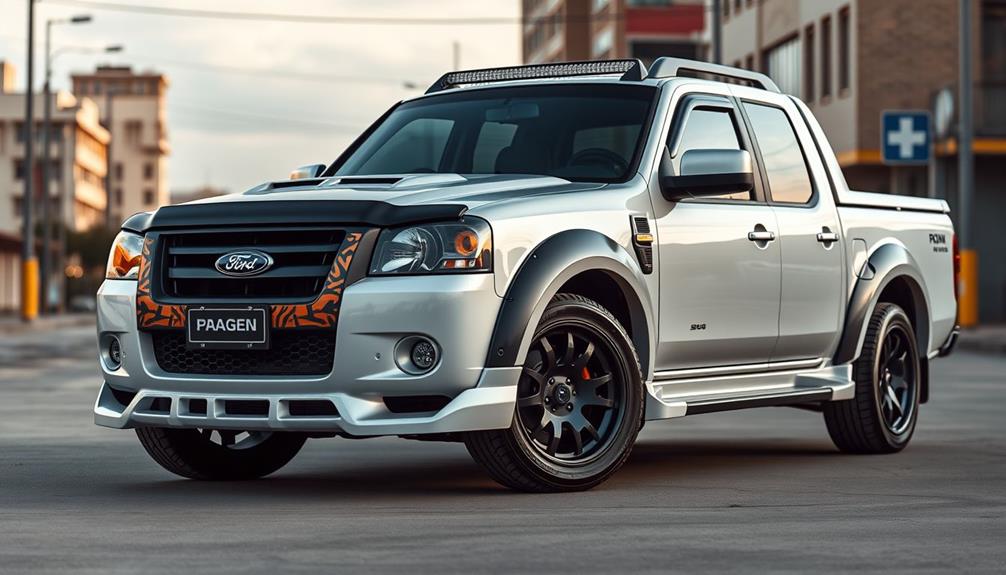
As you weigh your performance upgrade options for the 2005 Ford Ranger, it's important to recognize current market trends that can influence your choices. The aftermarket support for performance modifications, particularly for the 2.3L engine, is somewhat limited. This reality has led many enthusiasts to evaluate the 2.5L engine for better mod potential.
You'll find that common upgrades include airbox enhancements, drop-in filters, cat-back exhaust systems, and tuning options like the Xcal3, all aimed at improving horsepower and torque.
However, the availability of specific performance parts, such as K&N intakes for 04+ Duratec engines, has diminished considerably. This scarcity forces owners to explore less conventional or custom solutions.
Additionally, the performance tuning market mainly focuses on FWD platform-specific mods for vehicles like the Mazda3 and Focus, leaving fewer options for the Ranger community.
Despite these challenges, upgrading to aftermarket intercoolers and exhaust systems can yield notable performance improvements, with users reporting horsepower gains of up to 5-9 kW at the wheels.
Keeping these trends in mind will help you make informed decisions for your Ford Ranger performance modifications.
Effective Performance Upgrades

Releasing your 2005 Ford Ranger's potential starts with effective performance upgrades that can greatly enhance its capabilities.
These modifications not only boost horsepower but also improve your vehicle's overall drivability and fuel efficiency.
Here are some key upgrades you should consider:
- Aftermarket Airbox: Upgrading to a high-performance airbox can enhance airflow, increasing horsepower by up to 5.
- 3-Inch Exhaust System: Installing a full exhaust system with a high-flow catalytic converter can considerably improve exhaust flow, leading to better throttle response and horsepower gains.
- Custom Tuning with SCT: This device optimizes engine performance and can enhance fuel mileage by 1-5 MPG, depending on your modifications.
- Aftermarket Intercooler: Replacing the factory intercooler with an aluminum model can yield a performance increase of around 9 kW at the wheels, especially during high-demand conditions.
- High-Quality Coilovers: These improve suspension performance and vehicle handling, making your Ranger more responsive and stable on and off the road.
Tuning Process and Benefits

Tuning your 2005 Ford Ranger opens up a world of enhanced performance and efficiency. The tuning process involves fine-tuning fuel tables and timing, optimizing the air-fuel ratio (AFR) for better power and fuel economy. With custom tuning, you can boost horsepower and torque, potentially gaining 1-5 MPG depending on your modifications. Modern tuning upgrades can also help improve the responsiveness of your 2005 Ford Ranger, making it more enjoyable to drive. By utilizing advanced technology and data-logging capabilities, a professional tuner can precisely adjust the engine parameters to maximize performance. Additionally, modern tuning upgrades can also address any potential issues with the stock calibration, ensuring that your vehicle runs at its peak potential.
Here's a quick comparison of tuning benefits:
| Tuning Aspect | Stock Configuration | Tuned Configuration |
|---|---|---|
| Horsepower | Lower than potential | Increased by 10-20% |
| Torque | Limited for daily driving | Enhanced for towing |
| Shift Points | Factory settings | Optimized for performance |
| Throttle Response | Sluggish | Immediate and responsive |
| Speed Limiter | Active | Eliminated |
The tuning process also modifies shift strategies and pressures, allowing for firmer shifts and engaging higher RPMs. This means your Ranger can handle spirited driving and towing scenarios more effectively. Just remember, you'll need your SCT Serial Number and Vehicle VIN for proper ECU adjustments. Enjoy driving with the newfound performance!
Compliance and Limitations in Tuning
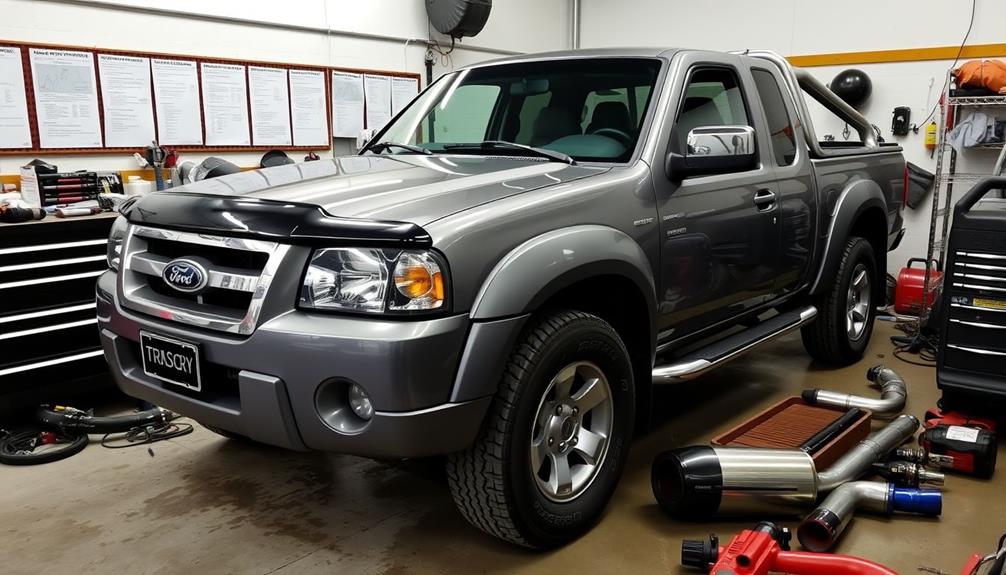
When considering tuning for your 2005 Ford Ranger, it's crucial to understand the compliance and limitations that come with it. Tuning modifications can enhance performance, but they must adhere to strict regulations, especially in places like California.
Here are some critical points to keep in mind:
- Custom tuning isn't available for sale in California due to emissions laws.
- You can't disable emissions components, including O2 sensors.
- The Check Engine Light (CEL) must remain functional.
- The EGR valve must stay connected during tuning processes.
- Custom tunes won't include emissions deletes or modifications.
As a vehicle owner, you're responsible for ensuring that any modifications comply with local emissions laws. This means that while you can optimize performance, you must do so without compromising the vehicle's compliance with emissions standards.
Understanding these limitations helps you make informed decisions about how to enhance your Ranger without running into legal issues or negatively impacting its performance. By focusing on compliant modifications, you can enjoy an upgraded driving experience without the worry of falling afoul of regulations.
Frequently Asked Questions
How Can I Make My 4.0 Ford Ranger Faster?
To make your 4.0 Ford Ranger faster, consider upgrading to a high-flow air intake, a 3-inch exhaust system, and custom tuning. These enhancements boost airflow, optimize fuel efficiency, and increase horsepower for better performance.
How to Make a 2.3 L Ranger Faster?
Imagine transforming your 2.3L Ranger into a speed machine. Start by upgrading the airbox and adding a high-flow filter; you'll notice improved airflow, boosting horsepower and responsiveness for an exhilarating driving experience.
How Much HP Can a Ford Ranger Make?
Your Ford Ranger can reach up to 160 hp with the right modifications and tuning. Upgrades like a high-flow exhaust, airbox, and proper tuning can greatly enhance your truck's performance and driving experience.
What Are the Best Mods for the 3.2 Ranger?
When you're looking to sprinkle some magic on your 3.2 Ranger, consider high-flow air filters, cat-back exhausts, performance tuners, upgraded intercoolers, and coilovers. These mods'll elevate your ride's performance and keep you grinning.
Conclusion
In the world of tuning your 2005 Ford Ranger, the sky's the limit when it comes to performance upgrades. With the right modifications, you can truly transform your ride into a powerhouse. By understanding the tuning process and staying aware of compliance issues, you'll guarantee a smooth journey ahead. So, roll up your sleeves and jump in—it's time to hit the road with confidence and release the full potential of your Ranger!

